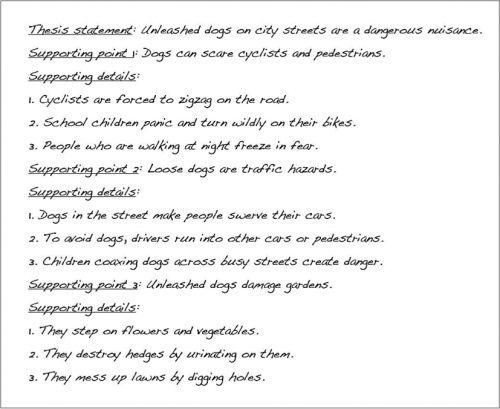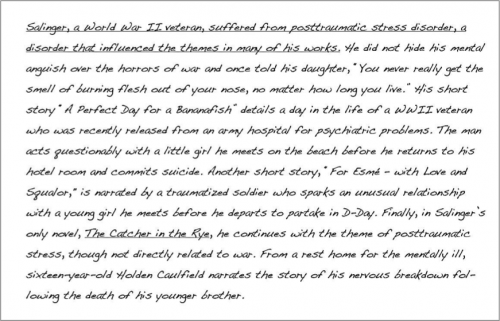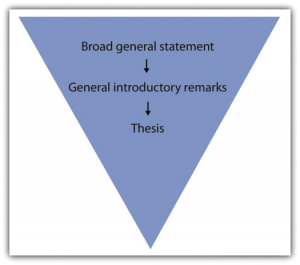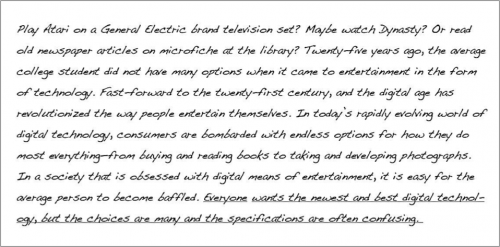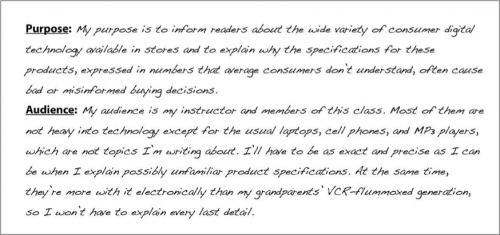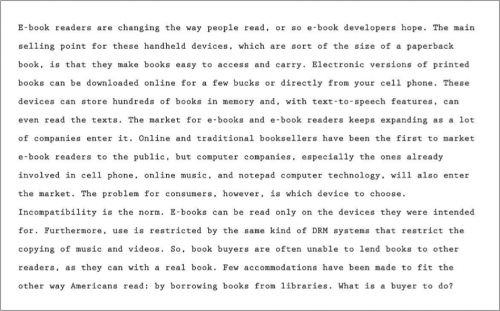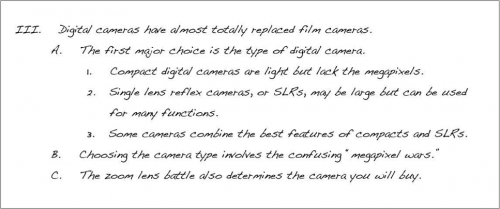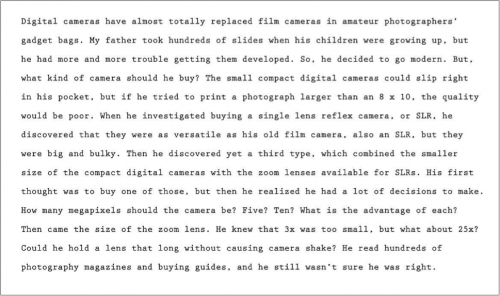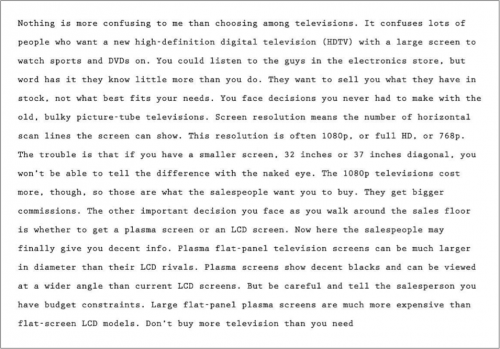Main Body
Chapter 6. Working toward the End Product: Composing a Draft
6.1 Writing Body Paragraphs
Learning Objectives
- Select primary support related to your thesis
- Support your topic sentences
Once you have completed your formal sentence outline, you will need to expand on that framework to create your expository essay. As much as you may be wanting to just get your ideas down and submit your paper, in order to make sure you are submitting a well-developed and strong essay, you need to make sure you are providing strong supporting ideas, developing paragraphs so they will fit together logically to best convince your reader, creating a strong introduction and conclusion, and revising your paper to catch issues you may have missed or not been aware of when writing.In this chapter, we will look at putting the pieces together to form a complete, revised, and supported expository essay, which you will need to submit next week.
If your thesis gives the reader a road map to your essay, then body paragraphs should closely follow that map. The reader should be able to predict what follows your introductory paragraph by simply reading the thesis statement.
The body paragraphs present the evidence you have gathered to confirm your thesis. Before you begin to support your thesis in the body, you must find information from a variety of sources that support and give credit to what you are trying to prove.
Select Primary Support for Your Thesis
Without primary support, your argument is not likely to be convincing. Primary support can be described as the major points you choose to expand on your thesis. It is the most important information you select to argue for your point of view. Each point you choose will be incorporated into the topic sentence for each body paragraph you write. Your primary supporting points are further supported by supporting details within the paragraphs.
Tip
Remember that a worthy argument is backed by examples. In order to construct a valid argument, good writers conduct a lot of background research and take careful notes. They also talk to people knowledgeable about a topic in order to understand its implications before writing about it.
Identify the Characteristics of Good Primary Support
In order to fulfill the requirements of good primary support, the information you choose must meet the following standards:
Be specific. The main points you make about your thesis and the examples you use to expand on those points need to be specific. Use specific examples to provide the evidence and to build upon your general ideas. These types of examples give your reader something narrow to focus on, and if used properly, they leave little doubt about your claim. General examples, while they convey the necessary information, are not nearly as compelling or useful in writing because they are too obvious and typical.
Be relevant to the thesis. Primary support is considered strong when it relates directly to the thesis. Primary support should show, explain, or prove your main argument without delving into irrelevant details. When faced with a lot of information that could be used to prove your thesis, you may think you need to include it all in your body paragraphs. But effective writers resist the temptation to lose focus. Choose your examples wisely by making sure they directly connect to your thesis.
Be detailed. Remember that your thesis, while specific, should not be very detailed. The body paragraphs are where you develop the discussion that a thorough essay requires. Using detailed support shows readers that you have considered all the facts and chosen only the most precise details to enhance your point of view.
Prewrite to Identify Primary Supporting Points for a Thesis Statement
Recall that when you prewrite you essentially make a list of examples or reasons why you support your stance. Stemming from each point, you further provide details to support those reasons. After prewriting, you are then able to look back at the information and choose the most compelling pieces you will use in your body paragraphs.
Select the Most Effective Primary Supporting Points for a Thesis Statement
After you have prewritten about your working thesis statement, you may have generated a lot of information, which may be edited out later. Remember that your primary support must be relevant to your thesis. Remind yourself of your main argument, and delete any ideas that do not directly relate to it. Omitting unrelated ideas ensures that you will use only the most convincing information in your body paragraphs. Choose at least three of the most compelling points. These will serve as the topic sentences for your body paragraphs.
When you support your thesis, you are revealing evidence. Evidence includes anything that can help support your stance. The following are the kinds of evidence you will encounter as you conduct your research:
Facts: Facts are the best kind of evidence to use because they often cannot be disputed. They can support your stance by providing background information on or a solid foundation for your point of view. However, some facts may still need explanation. For example, the sentence “The most populated province in Canada is Ontario” is a pure fact, but it may require some explanation to make it relevant to your specific argument.
Judgments: Judgments are conclusions drawn from the given facts. Judgments are more credible than opinions because they are founded upon careful reasoning and examination of a topic.
Testimony: Testimony consists of direct quotations from either an eyewitness or an expert witness. An eyewitness is someone who has direct experience with a subject; the witness adds authenticity to an argument based on facts. An expert witness is a person who has extensive experience with a topic. This person studies the facts and provides commentary based on either facts or judgments, or both. An expert witness adds authority and credibility to an argument.
Personal observation: Personal observation is similar to testimony, but personal observation consists of your testimony. It reflects what you know to be true because you have experiences and have formed either opinions or judgments about them. For instance, if you are one of five children and your thesis states that being part of a large family is beneficial to a child’s social development, you could use your own experience to support your thesis.
Writing at Work
In any job where you devise a plan, you will need to support the steps that you lay out. This is an area in which you would incorporate primary support into your writing. Choosing only the most specific and relevant information to expand upon the steps will ensure that your plan appears well thought out and precise.
Tip
You can consult a vast pool of resources to gather support for your stance. Citing relevant information from reliable sources ensures that your reader will take you seriously and consider your assertions. Use any of the following sources for your essay: newspapers or news organization websites, magazines, encyclopedias, and scholarly journals, which are periodicals that address topics in a specialized field.
Choose Supporting Topic Sentences
Each body paragraph contains a topic sentence that states one aspect of your thesis and then expands upon it. Like the thesis statement, each topic sentence should be specific and supported by concrete details, facts, or explanations.
Each body paragraph should comprise the following elements.
topic sentence + supporting details (examples, reasons, or arguments)
As you read in Chapter 5: Putting Your Ideas into Your Own Words andParagraphs, topic sentences indicate the location and main points of the basic arguments of your essay. These sentences are vital to writing your body paragraphs because they always refer back to and support your thesis statement. Topic sentences are linked to the ideas you have introduced in your thesis, thus reminding readers what your essay is about. A paragraph without a clearly identified topic sentence may be unclear and scattered, just like an essay without a thesis statement.
Tip
Unless your teacher instructs otherwise, you should include at least three body paragraphs in your essay. A five-paragraph/section essay, including the introduction and conclusion, is commonly the standard for exams and essay assignments.
Consider the following the thesis statement:
The following topic sentence is a primary support point for the thesis. The topic sentence states exactly what the controlling idea of the paragraph is. Later, you will see the writer immediately provide support for the sentence.
Self-practice EXERCISE 6.1
In Self–Practice Exercise 5.9, you chose three of your most convincing points to support the thesis statement you wrote. Now we are going to build onto the formal sentence outline you constructed in Self–Practice Exercise 5.14. Take each point and incorporate it into a topic sentence for each body paragraph.
Supporting point 1: ____________________________________________
Topic sentence: _______________________________________________________________________________
Supporting point 2: ____________________________________________
Topic sentence: _______________________________________________________________________________
Supporting point 3: ____________________________________________
Topic sentence: _______________________________________________________________________________
Collaboration: Please share with a classmate and compare your answers.
Draft Supporting Detail Sentences for Each Primary Support Sentence
After deciding which primary support points you will use as your topic sentences, you must add details to clarify and demonstrate each of those points. These supporting details provide examples, facts, or evidence that support the topic sentence.
The writer drafts possible supporting detail sentences for each primary support sentence based on the thesis statement:
The following paragraph contains supporting detail sentences for the primary support sentence (the topic sentence), which is underlined.
Self-practice EXERCISE 6.2
Using the three topic sentences you composed for the thesis statement in Self–Practice Exercise 6.1,draft at least three supporting details for each point.
Thesis statement: _____________________________________________________________________________
Primary supporting point 1: _____________________________________________________________________
Supporting details: ____________________________________________________________________________
Primary supporting point 2: _____________________________________________________________________
Supporting details: ____________________________________________________________________________
Primary supporting point 3: _____________________________________________________________________
Supporting details: ____________________________________________________________________________
Tip
You have the option of writing your topic sentences in one of three ways. You can state it at the beginning of the body paragraph, or at the end of the paragraph, or you do not have to write it at all. One that is not written at all is called an implied topic sentence. An implied topic sentence lets readers form the main idea for themselves. For beginning writers, it is best to not use implied topic sentences because it makes it harder to focus your writing. Your instructor may also want to clearly identify the sentences that support your thesis.
Tip
Print out the first draft of your essay and use a highlighter to mark your topic sentences in the body paragraphs. Make sure they are clearly stated and accurately present your paragraphs, as well as accurately reflect your thesis. If your topic sentence contains information that does not exist in the rest of the paragraph, rewrite it to more accurately match the rest of the paragraph.
Key Takeaways
- Your body paragraphs should closely follow the path set forth by your thesis statement.
- Strong body paragraphs contain evidence that supports your thesis.
- Primary support comprises the most important points you use to support your thesis.
- Strong primary support is specific, detailed, and relevant to the thesis.
- Prewriting helps you determine your most compelling primary support.
- Evidence includes facts, judgments, testimony, and personal observation.
- Reliable sources may include newspapers, magazines, academic journals, books, encyclopedias, and firsthand testimony.
- A topic sentence presents one point of your thesis statement while the information in the rest of the paragraph supports that point.
- A body paragraph comprises a topic sentence plus supporting details.
6.2 Writing Introductory and Concluding Paragraphs
Learning Objectives
- Recognize the importance of strong introductory and concluding paragraphs
- Learn to engage the reader immediately with the introductory paragraph
- Practise concluding your essays in a more memorable way
Picture your introduction as a storefront window: you have a certain amount of space to attract your customers (readers) to your goods (subject) and bring them inside your store (discussion). Once you have enticed them with something intriguing, you then point them in a specific direction and try to make the sale (convince them to accept your thesis).
Your introduction is an invitation to your readers to consider what you have to say and then to follow your train of thought as you expand upon your thesis statement.
An introduction serves the following purposes:
Establishes your voice and tone, or your attitude, toward the subject
Introduces the general topic of the essay
States the thesis that will be supported in the body paragraphs
Provides signposts of what you will discuss in your essay
First impressions are crucial and can leave lasting effects in your reader’s mind, which is why the introduction is so important to your essay. If your introductory paragraph is dull or disjointed, your reader probably will not have much interest in continuing with the essay.
Attracting Interest in Your Introductory Paragraph
Your introduction should begin with an engaging statement devised to provoke your readers’ interest. In the next few sentences, introduce them to your topic by stating general facts or ideas about the subject. As you move deeper into your introduction, you gradually narrow the focus, moving closer to your thesis. Moving smoothly and logically from your introductory remarks to your thesis statement can be achieved using a funnel technique, as illustrated in Figure 6.1: Funnel Technique.
Figure 6.1 Funnel Technique
Self-practice EXERCISE 6.3
On a sheet of paper, jot down a few general remarks that you can make about the topic for which you formed a thesis in Self–Practice Exercise 5.7.
Immediately capturing your readers’ interest increases the chances of having them read what you are about to discuss. You can garner curiosity for your essay in a number of ways. Try to get your readers personally involved by doing any of the following:
Appealing to their emotions
Using logic
Beginning with a provocative question or opinion
Opening with a startling statistic or surprising fact
Raising a question or series of questions
Presenting an explanation or rationalization for your essay
Opening with a relevant quotation or incident
Opening with a striking image
Including a personal anecdote
Tip
Remember that your diction, or word choice, while always important, is most crucial in your introductory paragraph. Boring diction could extinguish any desire a person might have to read through your discussion. Choose words that create images or express action.
In Chapter 5: Putting the Pieces Together with a Thesis Statement, you followed Mariah as she moved through the writing process. In this chapter, Mariah writes her introduction and conclusion for the same essay. Mariah incorporates some of the introductory elements into her introductory paragraph, which she previously outlined. Her thesis statement is underlined.
Tip
If you have trouble coming up with a provocative statement for your opening, it is a good idea to use a relevant, attention-grabbing quote about your topic. Use a search engine to find statements made by historical or significant figures about your subject.
Writing at Work
In your job field, you may be required to write a speech for an event, such as an awards banquet or a dedication ceremony. The introduction of a speech is similar to an essay because you have a limited amount of space to attract your audience’s attention. Using the same techniques, such as a provocative quote or an interesting statistic, is an effective way to engage your listeners. Using the funnel approach also introduces your audience to your topic and then presents your main idea in a logical manner.
Self-practice EXERCISE 6.4
Reread each sentence in Mariah’s introductory paragraph. Indicate which techniques she used and comment on how each sentence is designed to attract her readers’ interest.
Writing a Conclusion
It is not unusual to want to rush when you approach your conclusion, and even experienced writers may fade by the time they get to the end. But what good writers remember is that it is vital to put just as much attention into the conclusion as the rest of the essay. After all, a hasty ending can undermine an otherwise strong essay.
A conclusion that does not correspond to the rest of your essay, has loose ends, or is unorganized can unsettle your readers and raise doubts about the entire essay. However, if you have worked hard to write the introduction and body, your conclusion can often be the most logical part to compose.
The Anatomy of a Strong Conclusion
Keep in mind that the ideas in your conclusion must conform to the rest of your essay. In order to tie these components together, restate your thesis at the beginning of your conclusion. This helps you assemble, in an orderly fashion, all the information you have explained in the body. Repeating your thesis reminds your readers of the major arguments you have been trying to prove and also indicates that your essay is drawing to a close. A strong conclusion also reviews your main points and emphasizes the importance of the topic.
The construction of the conclusion is similar to the introduction, in which you make general introductory statements and then present your thesis. The difference is that in the conclusion you first paraphrase, or state in different words, your thesis and then follow up with general concluding remarks. These sentences should progressively broaden the focus of your thesis and manoeuvre your readers out of the essay.
Many writers like to end their essays with a final emphatic statement. This strong closing statement will cause your readers to continue thinking about the implications of your essay; it will make your conclusion, and thus your essay, more memorable. Another powerful technique is to challenge your readers to make a change in either their thoughts or their actions. Challenging your readers to see the subject through new eyes is a powerful way to ease yourself and your readers out of the essay.
Tip
When closing your essay, do not expressly state that you are drawing to a close. Relying on statements such as in conclusion, it is clear that, as you can see, or in summation is unnecessary and can be considered trite.
Tip
Avoid doing any of the following in your conclusion:
Introducing new material
Contradicting your thesis
Changing your thesis
Using apologies or disclaimers
Introducing new material in your conclusion has an unsettling effect on your reader. When you raise new points, you make your reader want more information, which you could not possibly provide in the limited space of your final paragraph.
Contradicting or changing your thesis statement causes your readers to think that you do not actually have a conviction about your topic. After all, you have spent several paragraphs adhering to a singular point of view. When you change sides or open up your point of view in the conclusion, your reader becomes less inclined to believe your original argument.
By apologizing for your opinion or stating that you know it is tough to digest, you are in fact admitting that even you know what you have discussed is irrelevant or unconvincing. You do not want your readers to feel this way. Effective writers stand by their thesis statement and do not stray from it.
Self-practice EXERCISE 6.5
On a sheet of a paper, restate your thesis from Self–Practice Exercise 5.7 and then make some general concluding remarks. Next, compose a final emphatic statement. Finally, incorporate what you have written into a strong conclusion paragraph for your essay.
Collaboration: Please share with a classmate and compare your answers
Mariah incorporates some of these pointers into her conclusion. She has paraphrased her thesis statement in the first sentence.
Tip
Make sure your essay is balanced by not having an excessively long or short introduction or conclusion. Check that they match each other in length as closely as possible, and try to mirror the formula you used in each. Parallelism strengthens the message of your essay.
Writing at Work
On the job you will sometimes give oral presentations based on research you have conducted. A concluding statement to an oral report contains the same elements as a written conclusion. You should wrap up your presentation by restating the purpose, reviewing the main points, and emphasizing the importance of the material you presented. A strong conclusion will leave a lasting impression on your audience.
Key Takeaways
- A strong opening captures your readers’ interest and introduces them to your topic before you present your thesis statement.
- An introduction should restate your thesis, review your main points, and emphasize the importance of the topic.
- The funnel technique to writing the introduction begins with generalities and gradually narrows your focus until you present your thesis.
- A good introduction engages people’s emotions or logic, questions or explains the subject, or provides a striking image or quotation.
- Carefully chosen diction in both the introduction and conclusion prevents any confusing or boring ideas.
- A conclusion that does not connect to the rest of the essay can diminish the effect of your paper.
- The conclusion should remain true to your thesis statement. It is best to avoid changing your tone or your main idea and avoid introducing any new material.
- Closing with a final emphatic statement provides closure for your readers and makes your essay more memorable.
6.3 Drafting
Learning Objectives
- Identify drafting strategies that improve writing
- Use drafting strategies to prepare the first draft of an essay
Drafting is the stage of the writing process in which you develop a complete first version of a piece of writing.
Even professional writers admit that an empty page scares them because they feel they need to come up with something fresh and original every time they open a blank document on their computers. Because you have completed the first two steps in the writing process, you have already recovered from empty-page syndrome. You have hours of prewriting and planning already done. You know what will go on that blank page: what you wrote in your outline.
Getting Started: Strategies for Drafting
Your objective for this portion is to draft the body paragraphs of a standard five-paragraph essay. A five-paragraph essay contains an introduction, three body paragraphs, and a conclusion. If you are more comfortable starting on paper than on the computer, you can begin that way and then later type it before you revise. You can also use a voice recorder to get yourself started, dictating a paragraph or two to get you thinking. In this lesson, Mariah does all her work on the computer, but you may use pen and paper or the computer to write a rough draft.
Making the Writing Process Work for You
What makes the writing process so beneficial to writers is that it encourages alternatives to standard practices while motivating you to develop your best ideas. For instance, the following approaches, done alone or in combination with others, may improve your writing and help you move forward in the writing process:
Begin writing with the part you know the most about. You can start with the third paragraph in your outline if ideas come easily to mind. You can start with the second paragraph or the first paragraph, too. Although paragraphs may vary in length, keep in mind that short paragraphs may contain insufficient support. Readers may also think the writing is abrupt. Long paragraphs may be wordy and may lose your reader’s interest. As a guideline, try to write paragraphs longer than one sentence but shorter than the length of an entire double-spaced page.
Write one paragraph at a time and then stop. As long as you complete the assignment on time, you may choose how many paragraphs you complete in one sitting. Pace yourself. On the other hand, try not to procrastinate. Writers should always meet their deadlines.
Take short breaks to refresh your mind. This tip might be most useful if you are writing a multi-page report or essay. Still, if you are impatient or cannot concentrate, take a break to let your mind rest. But do not let breaks extend too long. If you spend too much time away from your essay, you may have trouble starting again. You may forget key points or lose momentum. Try setting an alarm to limit your break, and when the time is up, return to your desk to write.
Be reasonable with your goals. If you decide to limit your breaks to 10 minutes, try to stick to that goal. If you told yourself that you need more facts, then commit to finding them. Holding yourself to your own goals will create successful writing assignments.
Keep your audience and purpose in mind as you write. These aspects of writing are just as important when you are writing a single paragraph for your essay as when you are considering the direction of the entire essay.
Of all of these considerations, keeping your purpose and your audience at the front of your mind is the most important to writing success. If your purpose is to persuade, for example, you will present your facts and details in the most logical and convincing way you can.
Your purpose will guide your mind as you compose your sentences. Your audience will guide word choice. Are you writing for experts, for a general audience, for other students, or for people who know very little about your topic? Keep asking yourself what your readers, with their background and experience, need to be told in order to understand your ideas. How can you best express your ideas so they are totally clear and your communication is effective?
Tip
You may want to identify your purpose and audience on an index card that you clip to your paper (or keep next to your computer). On that card, you may want to write notes to yourself—perhaps about what that audience might not know or what it needs to know—so that you will be sure to address those issues when you write. It may be a good idea to also state exactly what you want to explain to that audience, or to inform them of, or to persuade them about.
Writing at Work
Many of the documents you produce at work target a particular audience for a particular purpose. You may find that it is highly advantageous to know as much as you can about your target audience and to prepare your message to reach that audience, even if the audience is a co-worker or your boss. Menu language is a common example. Descriptions like “organic romaine” and “free-range chicken” are intended to appeal to a certain type of customer though perhaps not to the same customer who craves a thick steak. Similarly, mail-order companies research the demographics of the people who buy their merchandise. Successful vendors customize product descriptions in catalogues to appeal to their buyers’ tastes. For example, the product descriptions in a skateboarder catalogue will differ from the descriptions in a clothing catalogue for mature adults.
Setting Goals for Your First Draft
A draft is a complete version of a piece of writing, but it is not the final version. The step in the writing process after drafting, as you may remember, is revising. During revising, you will have the opportunity to make changes to your first draft before you put the finishing touches on it during the editing and proofreading stages. A first draft gives you a working version that you can later improve.
Self-practice EXERCISE 6.6
Using the topic for the essay that you outlined in Section 5.3: Outlining, describe your purpose and your audience as specifically as you can. Use your own sheet of paper to record your responses. Then keep these responses near you during future stages of the writing process.
My purpose: ______________________________________________________________________________________
______________________________________________________________________________________
______________________________________________________________________________________
My audience: ______________________________________________________________________________________
______________________________________________________________________________________
______________________________________________________________________________________
Writing at Work
Workplace writing in certain environments is done by teams of writers who collaborate on the planning, writing, and revising of documents, such as long reports, technical manuals, and the results of scientific research. Collaborators do not need to be in the same room, the same building, or even the same city. Many collaborations are conducted over the Internet.
In a perfect collaboration, each contributor has the right to add, edit, and delete text. Strong communication skills, in addition to strong writing skills, are important in this kind of writing situation because disagreements over style, content, process, emphasis, and other issues may arise.
The collaborative software, or document management systems, that groups use to work on common projects is sometimes called groupware or workgroup support systems.
The reviewing tool on some word processing programs also gives you access to a collaborative tool that many smaller work groups use when they exchange documents. You can also use it to leave comments to yourself.
Tip
If you invest some time now to investigate how the reviewing tool in your word processor works, you will be able to use it with confidence during the revision stage of the writing process. Then, when you start to revise, set your reviewing tool to track any changes you make, so you will be able to tinker with text and commit to only those final changes you want to keep.
Discovering the Basic Elements of a First Draft
If you have been using the information in this chapter step by step to help you develop an assignment, you already have both a formal topic outline and a formal sentence outline to direct your writing. Knowing what a first draft looks like will help you make the creative leap from the outline to the first draft. A first draft should include the following elements:
An introduction that piques the audience’s interest, tells what the essay is about, and motivates readers to keep reading
A thesis statement that presents the main point, or controlling idea, of the entire piece of writing
A topic sentence in each paragraph that states the main idea of the paragraph and implies how that main idea connects to the thesis statement
Supporting sentences in each paragraph that develop or explain the topic sentence. These can be specific facts, examples, anecdotes, or other details that elaborate on the topic sentence
A conclusion that reinforces the thesis statement and leaves the audience with a feeling of completion.
These elements follow the standard five-paragraph essay format, which you probably first encountered in high school. In Section 4.1: Expository Essays, you read that you should consider these as sections instead of just paragraphs because you will, at times, have to write a paper that needs to have more than five paragraphs because some ideas need more development or support. For now, however, Mariah focuses on writing the three body paragraphs from her outline.
The Role of Topic Sentences
Topic sentences make the structure of a text and the writer’s basic arguments easy to locate and comprehend. In post-secondary writing, using a topic sentence in each paragraph of the essay is the standard rule. However, the topic sentence does not always have to be the first sentence in your paragraph even if it the first item in your formal outline.
Tip
When you begin to draft your paragraphs, you should follow your outline fairly closely. After all, you spent valuable time developing those ideas. However, as you begin to express your ideas in complete sentences, it might strike you that the topic sentence might work better at the end of the paragraph or in the middle. Try it. Writing a draft, by its nature, is a good time for experimentation.
The topic sentence can be the first, middle, or final sentence in a paragraph. The assignment’s audience and purpose will often determine where a topic sentence belongs. When the purpose of the assignment is to persuade, for example, the topic sentence should be the first sentence in a paragraph. In a persuasive essay, the writer’s point of view should be clearly expressed at the beginning of each paragraph.
Choosing where to position the topic sentence depends not only on your audience and purpose but also on the essay’s arrangement, or order. When you organize information according to order of importance, the topic sentence may be the final sentence in a paragraph. All the supporting sentences build up to the topic sentence. Chronological order may also position the topic sentence as the final sentence because the controlling idea of the paragraph may make the most sense at the end of a sequence.
When you organize information according to spatial order, a topic sentence may appear as the middle sentence in a paragraph. An essay arranged by spatial order often contains paragraphs that begin with descriptions. A reader may first need a visual in mind before understanding the development of the paragraph. When the topic sentence is in the middle, it unites the details that come before it with the ones that come after it.
Tip
As you read critically throughout the writing process, keep topic sentences in mind. You may discover topic sentences that are not always located at the beginning of a paragraph. For example, fiction writers customarily use topic ideas, either expressed or implied, to move readers through their text. In nonfiction writing, such as the kind you read in popular magazines, topic sentences are often used when the author thinks it is appropriate (based on the audience and the purpose, of course). A single topic sentence might even control the development of a number of paragraphs.
Developing topic sentences and thinking about their placement in a paragraph will prepare you to write the rest of the paragraph.
Paragraphs
The paragraph is the main structural component of an essay as well as other forms of writing. Each paragraph of an essay adds another related main idea to support the writer’s thesis, or controlling idea. Each related main idea is supported and developed with facts, examples, and other details that explain it. By exploring and refining one main idea at a time, writers build a strong case for their thesis.
Starting Your First Draft
Now we are finally ready to look over Mariah’s shoulder as she begins to write her essay about digital technology and the confusing choices that consumers face. As she does, you should have in front of you your outline, with its thesis statement and topic sentences, and the notes you wrote earlier in this lesson on your purpose and audience. Reviewing these will put both you, like Mariah, in the proper mindset to start.
The following is Mariah’s thesis statement.
Here are the notes that Mariah wrote to herself to characterize her purpose and audience.
Mariah chose to begin by writing a quick introduction based on her thesis statement. She knew that she would want to improve her introduction significantly when she revised. Right now, she just wanted to give herself a starting point.
Tip
Remember Mariah’s other options. She could have started directly with any of the body paragraphs.
You learned more about writing attention-getting introductions and effective conclusions in Section 6.2: Writing Introductory and Concluding Paragraphs.
With her thesis statement and her purpose and audience notes in front of her, Mariah then looked at her sentence outline. She chose to use that outline because it includes the topic sentences. The following is the portion of her outline for the first body paragraph. The Roman numeral II identifies the topic sentence for the paragraph, capital letters indicate supporting details, and Arabic numerals label subpoints.
Mariah then began to expand the ideas in her outline into a paragraph. Notice how the outline helped her guarantee that all her sentences in the body of the paragraph develop the topic sentence.
Tip
If you write your first draft on the computer, consider creating a new file folder for each course with a set of subfolders inside the course folders for each assignment you are given. Label the folders clearly with the course names, and label each assignment folder and word processing document with a title that you will easily recognize. The assignment name is a good choice for the document. Then use that subfolder to store all the drafts you create. When you start each new draft, do not just write over the last one. Instead, save the draft with a new tag after the title—draft 1, draft 2, and so on—so that you will have a complete history of drafts in case your instructor wishes you to submit them.
In your documents, observe any formatting requirements—for margins, headers, placement of page numbers, and other layout matters—that your instructor requires.
Self-practice EXERCISE 6.7
Study how Mariah made the transition from her sentence outline to her first draft. First, copy her outline onto your own sheet of paper. Leave a few spaces between each part of the outline. Then copy sentences from Mariah’s paragraph to align each sentence with its corresponding entry in her outline.
Continuing the First Draft
Mariah continued writing her essay, moving to the second and third body paragraphs. She had supporting details but no numbered subpoints in her outline, so she had to consult her prewriting notes for specific information to include.
Tip
If you decide to take a break between finishing your first body paragraph and starting the next one, do not start writing immediately when you return to your work. Put yourself back in context and in the mood by rereading what you have already written. This is what Mariah did. If she had stopped writing in the middle of writing the paragraph, she could have jotted down some quick notes to herself about what she would write next.
Preceding each body paragraph that Mariah wrote is the appropriate section of her sentence outline. Notice how she expanded Roman numeral III from her outline into a first draft of the second body paragraph. As you read, ask yourself how closely she stayed on purpose and how well she paid attention to the needs of her audience.
Mariah then began her third and final body paragraph using Roman numeral IV from her outline.
Self-practice EXERCISE 6.8
Reread body paragraphs two and three of the essay that Mariah is writing. Then answer the questions on below your own sheet of paper.
In body paragraph two, Mariah decided to develop her paragraph as a nonfiction narrative. Do you agree with her decision? Explain. How else could she have chosen to develop the paragraph? Why is that better?
Compare the writing styles of paragraphs two and three. What evidence do you have that Mariah was getting tired or running out of steam? What advice would you give her? Why?
Choose one of these two body paragraphs. Write a version of your own that you think better fits Mariah’s audience and purpose.
Writing a Title
A writer’s best choice for a title is one that alludes to the main point of the entire essay. Like the headline in a newspaper or the big, bold title in a magazine, an essay’s title gives the audience a first peek at the content. If readers like the title, they are likely to keep reading.
Following her outline carefully, Mariah crafted each paragraph of her essay. Moving step by step in the writing process, Mariah finished the draft and even included a brief concluding paragraph. She then decided, as the final touch for her writing session, to add an engaging title.
Writing Your Own First Draft
Now you may begin your own first draft. Follow the suggestions and the guidelines presented in this section. Follow the steps below and work through the process just as Mariah did to develop her essay.
Also, your expository essay will be due next week, so focus on the first draft by the end of this week then take the next week to look it over. In Chapter 12, you will learn more about final revisions and peer review, so for your later papers, you will be expected to complete a more thorough revision; for the expository essay, you will be expected to work through your first draft, and once you are finished that, you will need to do a basic revision and editing, looking for errors with spelling, homonyms, sentence construction—all of the grammar content we have covered so far. For now, work through the following steps:
Ensure your supporting ideas actually support your thesis.
Revise your thesis as required (make sure it still addresses the initial topic you have chosen).
Compose your paragraphs/sections following your formal sentence outline—one section at a time–then double check you have included all information from your outline in your paragraph/section.
Check that your topic sentences support your thesis.
Make sure the information in your paragraphs support your topic sentences.
Insert transitional words (if you have not done so already when composing your draft) into paragraphs AND to link paragraphs.
When writing, be conscious of your tone and how it relates to your audience.
Be careful when considering which words to use.
Create an introduction that engages the reader.
Create a conclusion that leaves your reader convinced and is memorable.
Make sure all of your sentences are complete.
Proofread for spelling mistakes (remember to not depend too much on spelling and grammar checkers).
Try to compile a references section using the JIBC APA Style Guide (http://libguides.jibc.ca/apa); you will practise this later in this course, but for now refer to the guide to see how to compose a complete reference page, and be sure to include all of the sources you used.
Include citations within your essay to show where and when you have taken information from an external source. Again, follow the JIBC APA Style Guide (http://libguides.jibc.ca/apa). You will learn more about this is a few weeks, but refer to the guide to see how to format your citations. You need to include a citation after each piece of information taken from a source, and you may use the same citation multiple times in a row. (Try and get into the practice of doing this now because you will be expected to have these in all future papers to avoid plagiarism.)
Create a title page with interesting title, your name, your course name and number, your instructor’s name, the date the paper is due.
Key Takeaways
- Make the writing process work for you. Use any and all of the strategies that help you move forward in the writing process.
- Always be aware of your purpose for writing and the needs of your audience. Cater to those needs in every sensible way.
- Remember to include all the key structural parts of an essay: a thesis statement that is part of your introductory paragraph, three or more body paragraphs as described in your outline, and a concluding paragraph. Then add an engaging title to draw in readers.
- Write paragraphs of an appropriate length for your writing assignment. Paragraphs at this level of writing can be a page long, as long as they cover the main topics in your outline.
- Use your topic outline or your sentence outline to guide the development of your paragraphs and the elaboration of your ideas. Each main idea, indicated by a Roman numeral in your outline, becomes the topic of a new paragraph. Develop it with the supporting details and the subpoints of those details that you included in your outline.
- Generally speaking, write your introduction and conclusion last, after you have fleshed out the body paragraphs.
6.4 The Writing Process: End-of-Chapter Exercises
Learning Objectives
- Use the skills you have learned in the chapter
- Work collaboratively with other students
- Work with a variety of academic and on the job, real-world examples
Supplemental EXERCISES
In this chapter, you have thought and read about the topic of mass media. Starting with the title “The Future of Information: How It Will Be Created, Transmitted, and Consumed,” narrow the focus of the topic until it is suitable for a two- to three-page paper. Then narrow your topic with the help of brainstorming, idea mapping, and searching the Internet until you select a final topic to explore. Keep a journal or diary in which you record and comment on everything you did to choose a final topic. Then record what you will do next to explore the idea and create a thesis statement.
Write a thesis statement and a formal sentence outline for an essay about the writing process. Include separate paragraphs for prewriting, drafting, and revising and editing. Your audience will be a general audience of educated adults who are unfamiliar with how writing is taught at the post-secondary level. Your purpose is to explain the stages of the writing process so that readers will understand its benefits.
Collaboration: Please share with a classmate and compare your answers.
Pieces of writing in a variety of real-life and work-related situations would benefit from revising and editing. Consider the following list of real-life and work-related pieces of writing: emails, greeting card messages, junk mail, late night television commercials, social networking pages, local newspapers, bulletin board postings, and public notices. Find and submit at least two examples of writing that needs revision. Explain what changes you would make. Replace any recognizable names with pseudonyms.
Group activity. At work, an employer might someday ask you to contribute to the research base for an essay such as the one Mariah wrote or the one you wrote while working through this chapter. Choosing either her topic or your own, compile a list of at least five sources. Then, working in a group of four students, bring in printouts or PDF files of Internet sources or paper copies of non-Internet sources for the other group members to examine. In a group report, rate the reliability of each other’s sources.
Group activity. Working in a peer review group of four, go to Section 6.3: Drafting and reread the draft of the first two body paragraphs of Mariah’s essay, “Digital Technology: The Newest and the Best at What Price?” Review those two paragraphs and suggest and agree on changes to improve unity and coherence, eliminate unneeded words, and refine word choice. Your purpose is to help Mariah produce two effective paragraphs for a formal post-secondary-level essay about her topic.
Journal entry #6
Write a paragraph or two responding to the following.
How do you feel about beginning your expository essay draft? Which, if any, of the steps do you find intimidating? OR Which steps do you find straightforward?
You were given a few tips about making the writing process for you? Which of these did you try?
How did breaking the writing process down into smaller stages work for you? What effect did this process have on the end result? What would have been different if you had just tackled your paper in one sitting?
Remember as mentioned in the Assessment Descriptions in your syllabus:
You will be expected to respond to the questions by reflecting on and discussing your experiences with the week’s material.
When writing your journals, you should focus on free writing—writing without (overly) considering formal writing structures—but you want to remember that it will be read by the instructor, who needs to be able to understand your ideas.
Your instructor will begin reading your Journal Package 1 this week. (2.5%)



